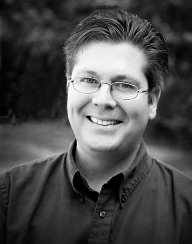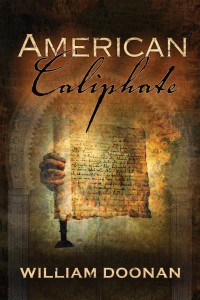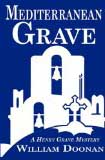This week, I’m honored to have a distinguished guest blogger. William Doonan is an archaeologist and professor of anthropology. He also writes very interesting books. I just finished one of his books with protagonist Henry Grave – a character you won’t soon forget. But, enough from me. let’s hear from William Doonan.
Thanks for letting me visit with you, Jim. My new archaeological mystery American Caliphate was just released by Dark Oak Mysteries, and I’ve been getting a lot of questions about archaeology and history. So I wanted to speak to that.
I am an archaeologist and a college professor. I’ve worked on excavations in many different parts of the world, but I’ve focused on Central and South America. Recently, I spent five summers excavating a pre-Inca pyramid complex on the north coast of Peru. The site was called El Brujo, roughly translating to ‘the shaman’ or ‘the magician,’ and it was the most interesting project I’ve ever been part of.
What was fascinating to me was the fact that a culture called Moche built their mud brick pyramids over a period of about eight hundred years. As soon as they finished, they’d start a new phase, making the pyramids even bigger. In Peru, and in many parts of the new world, building on top of something honors it.
In 1548, the Spanish built a church on the plaza in front of one of these pyramids. It would have been one of the earliest Christian churches in South America. And clearly, what the Spanish priests were doing, by putting their church on top of a holy place, was making a statement of domination. For Europeans, building on top of something means dominating it. But not for the Peruvians. So I don’t think these two groups really understood each other.
As we started excavating this church, we discovered that some of the artwork adorning its walls was not Christian at all. It was native religious symbolism. This got us thinking — why would missionary priests, who had been sent halfway around the world to convert the natives, tolerate something like that?
Well, I don’t know. The evidence only takes us so far. As an archaeologist, I can’t formulate conclusions that overstep my evidence. But as a fiction writer, I’m free to do just that. So here’s what I think happened:
In 1532, Francisco Pizarro and his army of 180 swordfighters captured the Inca emperor Atahualpa. Meanwhile back in Spain, religious fever was burning. The Inquisition was going full tilt, and the Moors had all been converted or expelled. But that’s not true, of course. Many continued practicing Islam in secret, and many emigrated to the Americas. Officially it was illegal for a Muslim to sail from Spain to Peru. But it was also officially illegal to be a Muslim in Spain! So that’s kind of a loophole.
I suspect Spanish Moors came to Peru by the thousands. Judging by the architecture in the older sections of Lima and Cuzco, I think the descendants of these Moors still live there. But back to that church, and those missionary priests who were tolerating native religious artwork. Here’s what nobody suspected. The Inquisition was already so out of control and so insane, that no priest in his right mind would dare report any problems, any heresy to their superiors. They’d be risking their own necks.
Religious conversion is a painstaking and problematic endeavor on a good day. And if you were a missionary priest in colonial Peru, you were probably the tenth son of a poor farmer with dim prospects. It was either the priesthood or the poorhouse. So you did what you were told, you did your job, you wrote your reports about how well the natives were getting on with Jesus, singing the hymns and all. And then you did what you had to do to survive. And if that meant turning a blind eye while the indians prayed to some of the old gods, then so be it. And if the occasional Moor showed up, you let that slide as well.
 So that’s the landscape in which I set my story. American Caliphate is based on the archaeological evidence we developed during our excavations, but it exceeds the evidence by a considerable margin. Here’s a blurb:
So that’s the landscape in which I set my story. American Caliphate is based on the archaeological evidence we developed during our excavations, but it exceeds the evidence by a considerable margin. Here’s a blurb:
Archaeologists Jila Wells and Ben Juarez are not thrilled at the prospect of returning to Peru. The ambush that nearly cost Jila her life still haunts her. But the ruined pyramids at Santiago de Paz hide an important document that would shock the Islamic world. Professor Sandy Beckham is assembling a distinguished team to dig quickly through the pyramid complex, following clues found in the diary of a wealthy Muslim woman who lived in Spain five centuries ago.
In the diary are details of an illegal expedition to Spanish Peru in three well-armed ships. Convinced that Spain was forever lost to Islam, Diego Ibanez intended to bring the word of Allah to the pagan Americans. Landing on Peru’s north coast, he learned that the fires of the Inquisition burned even hotter there than they did in Spain.
As the archaeologists brace for the ravaging storms of El Niño, Jila and Ben hurry to complete their excavations. But they’re not the only ones interested in this project. Other forces are determined that the document remains hidden. Should it be discovered, a challenge could be made under Islamic testamentary law to the throne of Saudi Arabia. And the House of Saud has no interest in sharing power with an American caliphate that might now awaken from a five hundred year slumber.
JRC: He’s convinced me. I want to read American Caliphate.
William Doonan is an archaeologist and professor of anthropology in Sacramento,CA. He has spent many years conducting excavations in Central and South America. He is also a veteran cruise ship lecturer, traveling the world and speaking on topics as diverse as the Trojan War, piracy in the Adriatic, and the peopling of the Am ericas.
ericas.
Doonan is also the author of three mystery novels. Grave Passage and Mediterranean Grave recount the adventures of an octogenarian detective who solves crimes on cruise ships. His new archaeological mystery American Caliphate was released by Dark Oak Mysteries in April 2012
Doonan lives in Sacramento with his wife and two sons. He blogs about undead conquistador mummies at http://www.themumiesofblogspace9.com.

Mrs. Fister, this message is your next bit of information. Do message the agency at your earliest convenience. No further information until next transmission. This is broadcast #3698. Do not delete.
The next time I learn a blog, I hope that it doesnt disappoint me as a lot as this one. I mean, I know it was my option to read, however I truly thought youd have something interesting to say. All I hear is a bunch of whining about something that you could possibly repair when you werent too busy in search of attention.
(So sorry in replying late) I loved this interview, Jim thank you for interviewing William whose story telling is wonderful. I love (real) History mixed with fiction, which is a great toss of the coin be it American, European, Incas, Aztec etc. The flavor works. Augie Hicks
Love the archaeological basis for your book. Speculation from what isn’t there is always an exciting place to start from–and no one can refute it. Now I have to read American Caliphate.
Your book sounds fascionating, William. There’s evidence in the British isles as well of Christians building churches atop pagan sites. Some feel that certain aspects of the Catholic church, such as veneration of the Virgin Mary, were rooted in paganism. I’m not being disrespectful of the church (I’m a believer myself), but it’s interesting how these strands come together. Good luck with your book!
Sally Carpenter
Sally,
Great point. The Christians might have been trying to eradicate the pagan sites, but in the process of doing so, they wound up giving them more power. When the Romans tried to rid western Europe of its obsession with the goddess Oestra, they wound up with Easter, which we still celebrate. You’re right – it is interesting how the strands come together.
Another wonderful interview, Jim!
William, I love learning more about you and your books. “Mediterranean Grave” was fantastic and I look forward to reading “American Caliphate.”
I also look forward to your interview on my blog tomorrow!
Thanks, Patricia! Let me know what you think of the book. It was a lot of fun to write.